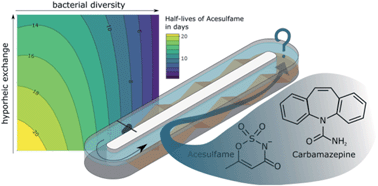Using recirculating flumes and a response surface model to investigate the role of hyporheic exchange and bacterial diversity on micropollutant half-lives†
Abstract
Enhancing the understanding of the fate of wastewater-derived organic micropollutants in rivers is crucial to improve risk assessment, regulatory decision making and river management. Hyporheic exchange and sediment bacterial diversity are two factors gaining increasing importance as drivers for micropollutant degradation, but are complex to study in field experiments and usually ignored in laboratory tests aimed to estimate environmental half-lives. Flume mesocosms are useful to investigate micropollutant degradation processes, bridging the gap between the field and batch experiments. However, few studies have used flumes in this context. We present a novel experimental setup using 20 recirculating flumes and a response surface model to study the influence of hyporheic exchange and sediment bacterial diversity on half-lives of the anti-epileptic drug carbamazepine (CBZ) and the artificial sweetener acesulfame (ACS). The effect of bedform-induced hyporheic exchange was tested by three treatment levels differing in number of bedforms (0, 3 and 6). Three levels of sediment bacterial diversity were obtained by diluting sediment from the River Erpe in Berlin, Germany, with sand (1 : 10, 1 : 1000 and 1 : 100 000). Our results show that ACS half-lives were significantly influenced by sediment dilution and number of bedforms. Half-lives of CBZ were higher than ACS, and were significantly affected only by the sediment dilution variable, and thus by bacterial diversity. Our results show that (1) the flume-setup is a useful tool to study the fate of micropollutants in rivers, and that (2) higher hyporheic exchange and bacterial diversity in the sediment can increase the degradation of micropollutants in rivers.



 Please wait while we load your content...
Please wait while we load your content...